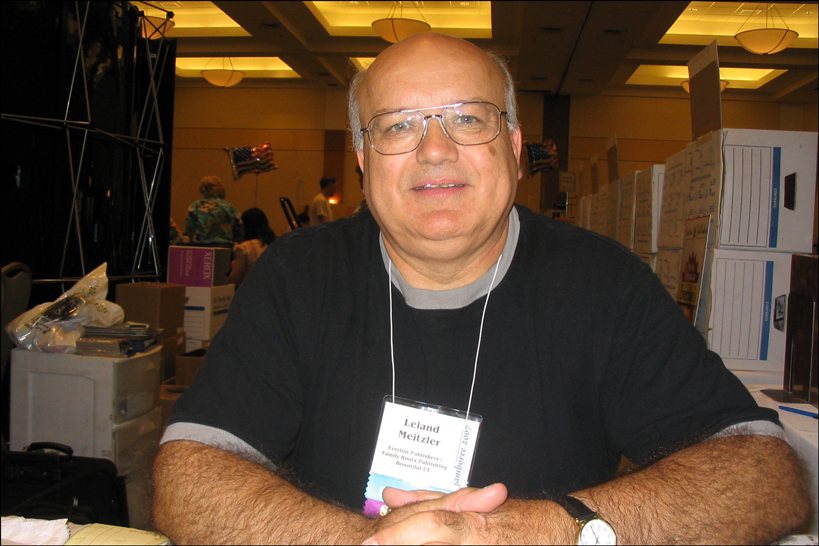The last lecture I attended in the morning at Jamboree 2007 was “Finding the Women in Your Pedigree” presented by Leland Meitzler.
Leland Meitzler at Jamboree 2007
I was a few minutes late getting to Leland Meitzler’s lecture and couldn’t find an empty chair in the lecture hall. Nonetheless, I found a couple of square feet of empty floor space and enjoyed the lecture from there.
Leland talked about 23 sources to find the women in your pedigree.
-
Marriage records, including marriage applications, marriage licenses, marriage bonds, marriage returns, marriage certificates, and permissions to marry. These records will often list the maiden name of the bride and, if the bride is underage, a marriage consent will list the name of a parent with the parent’s signature.
-
The Family Bible will often be full of maiden names. The most difficult part of researching the Family Bible is finding out who owns the Bible. Typically, the person who has possession of the Bible was often the person who got their hands on it first.
-
Death Certificates are a relatively new invention, and frequently provide maiden names. Unfortunately, the person who provided the maiden name for a death certificate sometimes wasn’t a very good source for the name.
-
Federal Census Records may provide useful information on maiden names if in-laws were living with the family. Sometimes the same in-law will be listed in the census with more than one family, providing information on the maiden name for multiple daughters.
-
State Census Records may provide more information than Federal Census Records since the State Census asked different questions than the Federal Census did. State Census Records may show if a couple was married in the last year and may even provide maiden names.
-
The International Genealogy Index is a source for maiden names, but should be used with caution, since the reliability of user-provided information is sometimes questionable.
-
Cemeteries can show a variety of family relationships. Look at who is buried in the family plot and who is buried nearby.
-
Birth Indexes may provide the maiden name of the mother.
-
State Specific Indexes and Collections such as the Barbour Collection and the Ricker Collection can be a very useful source of maiden names.
-
Surname Files found in nearly every library with a genealogy collection should not be overlooked.
-
Historical Society Questionnaires are another source for maiden names.
-
Obituaries and Death Notices frequently provide the maiden name for deceased women, but may also provide the names of siblings, parents, and other survivors.
-
Cards of Thanks can be a rich source of names, since they often provide the names of everyone who attended a funeral.
-
D.A.R. Lineage Papers and Books are a great source of names for those who can trace their ancestry back to the American Revolution.
-
Funeral Home Records can be a great source of names, especially because funeral homes often have a close association with cemeteries and courthouses.
-
Death Registers in the town hall provide a source of information that frequently precedes Death Certificates required by the state.
-
State Hospitals are often reluctant to release information, but a request from a direct descendant looking for information for medical reasons and the signature of a medical doctor may open doors.
-
Church Membership Records are another useful source of names for tracing the women in your family.
-
Church Marriage Records, like civil registrations of marriage are some of the best sources of maiden names.
-
Church Birth Records may directly provide the maiden names of the mother. The Godparents or witnesses may also be related to the mother and may provide clues to the mother’s maiden name.
-
Pension Files and Bounty Land Files are possibly an unexpected source of information about female ancestors. Sometimes laws changed after a pensioner had died, and so descendants applied for the pension. Women had to provide a lot of genealogical information for her claim. The widow had to provide proof of marriage.
-
Deeds may show family relationships and maiden names.
-
Social Security Applications provide the maiden name of a woman even when the SSDI lists only the married name.
Leland recommended Christina Schaefer’s book for more information (the citation below was automatically generated according to the Chicago Manual of Style at Worldcat.org):
Schaefer, Christina K. 1999. The hidden half of the family: a sourcebook for women’s genealogy. Baltimore, Md: Genealogical Pub. Co.
Copyright © 2007 by Stephen J. Danko





